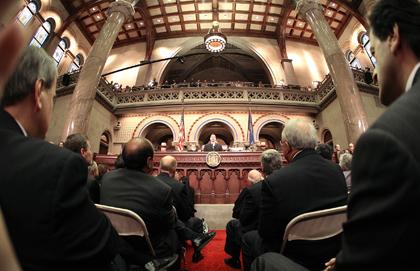By Jeremy Walsh
Belt tightening — both fiscal and physical — and green energy initiatives were among the central themes of Gov. David Paterson’s rhetoric−heavy first State of the State address. Speaking for roughly an hour and a half, the governor touched on many of the items included in his proposed budget, which he introduced Dec. 16, 2008.
“Our economic obstacles seem overwhelming, but each time a challenge has faced New Yorkers, we have learned a way to rebuild our future,” Paterson said, referring to a projected state budget deficit of nearly $15 billion for the upcoming fiscal year. “This is a moment for leadership, not partisanship. Not in any way salesmanship, but real leadership.”
The speech, which relied heavily on language about the historical resilience of New Yorkers, was unusual because it came after the governor delivered his proposed budget to the Legislature, state Sen. Toby Stavisky (D−Flushing) said.
“It’s as though you have the skeleton as the State of the State and then the meat and everything else is the budget,” she said.
The governor once again stressed the importance of his proposed tax on sugar in sodas as a step toward reducing the prevalence of childhood obesity as well as proposed changes to healthcare and called for major revisions to the controversial Empire Zone program for small businesses.
“Childhood obesity occurs in one in four New Yorkers,” he said. “It contributes to other health problems like Type 2 diabetes, high blood pressure and high cholesterol. … I don’t think parents know the relationships between their children’s habits and acquiring these diseases.”
Paterson also called for the establishment of a $350 million state−funded student loan program and called for the start of an initiative to make upstate New York a hub for the development of next−generation hybrid vehicle technology.
The speech brought praise from Queens elected officials.
“The governor finally moved beyond the mantra of cut, cut, cut and offered some proactive strategies for growing the economy and protecting New Yorkers during the downturn,” said Assemblyman Rory Lancman (D−Fresh Meadows). “His emphasis on shared sacrifice turns a page on the debate over the millionaire’s tax. I think he recognizes that the budget can’t be balanced by nickel and diming the middle class to death.”
City Councilman John Liu (D−Flushing), chairman of the Council Transportation Committee, hailed Paterson’s call for the state to heed the recommendations for new revenue sources and repairs to the Metropolitan Transportation Authority recommended by the Ravitch Commission.
“Investment in our aging infrastructure, from bridges to subways, is imperative for our short−term well−being and safety as well as for the long term health of the economy,” Liu said. “This is the first time in a long time that such a high priority has been placed on updating our vital infrastructure.”
But Paterson did take some flak from state Republican Committee Chairman Joseph Mondello, who accused the governor of not going far enough in slashing spending.
“The governor should have been honest with the people of New York and stated that state government has no choice but to meet this unprecedented crisis by immediately beginning to unsnarl and unravel the vast state bureaucracy, rein in the ever−expanding network of entitlement programs and enact deep and across−the−board cuts in state spending,” he said.
Paterson, who is legally blind, also earned respect for memorizing the speech, which included statistics and quotes from a favorite elementary school poem. He admitted in interviews afterward that he was nervous about his delivery.
“It was remarkable that he was able to speak an hour and a quarter,” Stavisky said. “I’ve heard better speeches, but for someone to memorize this … is just incredible.”
Reach reporter Jeremy Walsh by e−mail at jwalsh@timesledger.com or by phone at 718−229−0300, Ext. 154.
































